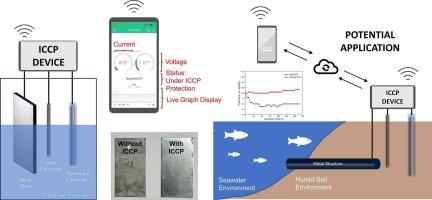将物联网自动外加电流阴极保护系统与金属电位监测相结合:一种解决腐蚀问题的数字技术方法,以促进环境生态系统保护
IF 5.6
2区 工程技术
Q1 ENGINEERING, MULTIDISCIPLINARY
引用次数: 0
摘要
该研究的重点是开发具有金属电位监测功能的物联网(IoT)自动化外加电流阴极保护(ICCP)设备,旨在解决腐蚀预测问题,同时保护环境生态系统。通过将自动化和物联网技术整合到ICCP电化学装置中,该装置不仅可以为金属提供功能性抗腐蚀功能,还可以通过电位读数实时监测其腐蚀状态。在几种腐蚀条件下,以锌和铁金属作为保护对象,进行了几次腐蚀实验来研究所建装置的有效性。结果表明,与未保护的金属相比,具有ICCP的保护金属始终具有较低的电位读数。这些潜在趋势值表明了ICCP的有效性能,证实了该器件对Zn和Fe的腐蚀抑制效率分别达到88% ~ 90%和93% ~ 95%。此外,该设备还能够通过Wi-Fi通信使用Blynk物联网平台将数据发送到用户界面移动应用程序,随时随地提供实时数据访问和远程监控。因此,将传统的ICCP系统与自动化和物联网技术相结合,可以提高作业效率和防腐效果。通过实施防腐蚀技术,该设备将成为金属降解环境保护的支撑系统,突出维护健康的重要性,确保环境中自然资源的保护和生态的稳定。本文章由计算机程序翻译,如有差异,请以英文原文为准。

Integrating IoT-enabled automated impressed current cathodic protection systems with metal potential monitoring: a digital technology approach to address corrosion for promoting environmental ecosystem conservation
The study focuses on the development of an Internet of Things (IoT)-enabled automated Impressed Current Cathodic Protection (ICCP) device with metal potential monitoring features, aimed at addressing corrosion anticipation while protecting environmental ecosystems. By incorporating automation and IoT technology into the ICCP electrochemical setup, the built device not only serves functional corrosion immunity for metals but also enables real-time monitoring of their corrosion status through potential reading. Several corrosion experiments were conducted to investigate the built device’s effectiveness, with Zn and Fe metals as the objects to be protected under several corrosive conditions. The results indicated that the protected metal with ICCP always had lower potential readings compared to the non-protected metal. These potential trend values suggest the effective performance of ICCP, confirming the device’s potential capability to inhibit corrosion up to efficiency levels of 88% − 90% and 93% − 95% for Zn and Fe, respectively. Moreover, the device is also capable of sending data to a user interface mobile application using the Blynk IoT Platform over Wi-Fi communication, offering real-time data access and remote monitoring at anytime and anywhere. Thus, the integration of conventional ICCP systems with automation and IoT technology serves potential benefits to improve operational efficiency and effectiveness of corrosion protection. By implementing the corrosion protection technology, the device will act as the supporting system for environmental protection due to metal degradation, highlighting the importance of maintaining health as well as assuring natural resource protection and ecological stability in the environments.
求助全文
通过发布文献求助,成功后即可免费获取论文全文。
去求助
来源期刊

Measurement
工程技术-工程:综合
CiteScore
10.20
自引率
12.50%
发文量
1589
审稿时长
12.1 months
期刊介绍:
Contributions are invited on novel achievements in all fields of measurement and instrumentation science and technology. Authors are encouraged to submit novel material, whose ultimate goal is an advancement in the state of the art of: measurement and metrology fundamentals, sensors, measurement instruments, measurement and estimation techniques, measurement data processing and fusion algorithms, evaluation procedures and methodologies for plants and industrial processes, performance analysis of systems, processes and algorithms, mathematical models for measurement-oriented purposes, distributed measurement systems in a connected world.
 求助内容:
求助内容: 应助结果提醒方式:
应助结果提醒方式:


